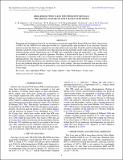| dc.contributor.author | Oskinova, Lidia M. | |
| dc.contributor.author | Gayley, K. G. | |
| dc.contributor.author | Hamann, W.-R. | |
| dc.contributor.author | Ignace, R. | |
| dc.contributor.author | Pollock, A. M. T. | |
| dc.contributor.author | Huenemoerder, David P. | |
| dc.date.accessioned | 2015-02-20T19:13:29Z | |
| dc.date.available | 2015-02-20T19:13:29Z | |
| dc.date.issued | 2012-02 | |
| dc.date.submitted | 2012-01 | |
| dc.identifier.issn | 2041-8205 | |
| dc.identifier.issn | 2041-8213 | |
| dc.identifier.uri | http://hdl.handle.net/1721.1/95464 | |
| dc.description.abstract | We present the first high-resolution X-ray spectrum of a putatively single Wolf-Rayet (WR) star. 400 ks observations of WR 6 by the XMM-Newton telescope resulted in a superb quality high-resolution X-ray spectrum. Spectral analysis reveals that the X-rays originate far out in the stellar wind, more than 30 stellar radii from the photosphere, and thus outside the wind acceleration zone where the line-driving instability (LDI) could create shocks. The X-ray emitting plasma reaches temperatures up to 50 MK and is embedded within the unshocked, "cool" stellar wind as revealed by characteristic spectral signatures. We detect a fluorescent Fe line at ≈6.4 keV. The presence of fluorescence is consistent with a two-component medium, where the cool wind is permeated with the hot X-ray emitting plasma. The wind must have a very porous structure to allow the observed amount of X-rays to escape. We find that neither the LDI nor any alternative binary scenario can explain the data. We suggest a scenario where X-rays are produced when the fast wind rams into slow "sticky clumps" that resist acceleration. Our new data show that the X-rays in single WR star are generated by some special mechanism different from the one operating in the O-star winds. | en_US |
| dc.description.sponsorship | United States. National Aeronautics and Space Administration (Grant SV3-73016) | en_US |
| dc.language.iso | en_US | |
| dc.publisher | IOP Publishing | en_US |
| dc.relation.isversionof | http://dx.doi.org/10.1088/2041-8205/747/2/l25 | en_US |
| dc.rights | Article is made available in accordance with the publisher's policy and may be subject to US copyright law. Please refer to the publisher's site for terms of use. | en_US |
| dc.source | American Astronomical Society | en_US |
| dc.title | HIGH-RESOLUTION X-RAY SPECTROSCOPY REVEALS THE SPECIAL NATURE OF WOLF-RAYET STAR WINDS | en_US |
| dc.type | Article | en_US |
| dc.identifier.citation | Oskinova, L. M., K. G. Gayley, W.-R. Hamann, D. P. Huenemoerder, R. Ignace, and A. M. T. Pollock. “HIGH-RESOLUTION X-RAY SPECTROSCOPY REVEALS THE SPECIAL NATURE OF WOLF-RAYET STAR WINDS.” The Astrophysical Journal 747, no. 2 (February 21, 2012): L25. © 2012 The American Astronomical Society | en_US |
| dc.contributor.department | MIT Kavli Institute for Astrophysics and Space Research | en_US |
| dc.contributor.mitauthor | Huenemoerder, David P. | en_US |
| dc.relation.journal | The Astrophysical Journal. Letters | en_US |
| dc.eprint.version | Final published version | en_US |
| dc.type.uri | http://purl.org/eprint/type/JournalArticle | en_US |
| eprint.status | http://purl.org/eprint/status/PeerReviewed | en_US |
| dspace.orderedauthors | Oskinova, L. M.; Gayley, K. G.; Hamann, W.-R.; Huenemoerder, D. P.; Ignace, R.; Pollock, A. M. T. | en_US |
| mit.license | PUBLISHER_POLICY | en_US |
| mit.metadata.status | Complete | |
